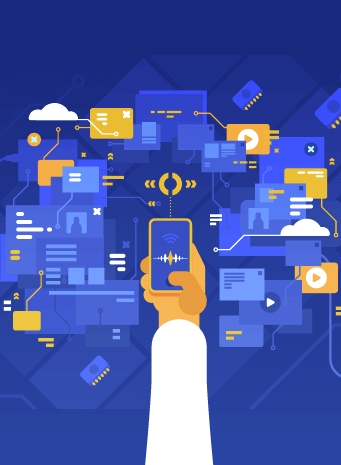Startup growth business can feel like a Sisyphean task — pushing a boulder up a hill only to have it roll away from you. You’ve got a ton of tasks to do and limited resources with which to get it done.
Meanwhile, your first customers are chomping at the bit for the latest improvements to the product or complaining about the current bugs. They’re also uninstalling your app, causing you to lose more customers than you’ve actually acquired.
But it doesn’t have to be like this.
There is a not-so-secret tool that startups have been using for years with great success — one that provides your marketing funnel with a constant stream of new leads and one that nurtures casual users into loyal customers. Suddenly, you’re not manually pushing huge boulders up a hill, you’re employing heavy machinery to pull them up for you while you call the shots.
I’m talking about mobile marketing. And with the right tools and strategies in place, your startup can scale without breaking a sweat.
Smartphones Vs Everything Else
The logic is simple: in order to reach prospective customers, you have to be where they are. And in this day and age of near-constant change and a crippling crisis, you can rest assured that people are on their smartphones more than any other device.
In March 2020, data from a global survey of 12,500 internet users around the world shows that 70% of users have increased the usage of their smartphones as a direct result of the COVID-19 outbreak. In comparison, the use of laptops, desktops, tablets, and streaming services don’t even approach the usage time that smartphones get. *

Chart showing increased media device usage due to COVID-19. March 2020.
Below are several tactics you need to use. Each growth hacking strategy is a way for you to capture a user’s attention while on their smartphones.
Startup Growth? SMS Marketing Still Works
SMS is still one of the most effective channels for growth marketing. You might think that SMS marketing is old school and probably ignored by many consumers because it isn’t cool. Wrong!
First off, people are texting now more than ever. A May 2020 study of over 2,200 phone users revealed that more than a third (37%) of users are texting more. *

Furthermore, the engagement that you can get from SMS marketing is amazing, particularly for startups that need quick wins.
Texting has the highest engagement rate in any marketing medium with their 82% open rates. Additionally, 90% of text messages are read within three seconds! *
Why though? What makes text so effective?
The Appeal of SMS
It’s about the relevance of text messages. Most consumers already prefer to get things like order status alerts, reservation confirmations, and appointment reminders via SMS. And an amazing 90% of leads would prefer to be texted than called. *
An added component in its appeal is its urgency and the immediacy with which you can get responses. More than half of all consumers say they prefer to contact support via SMS over all other channels.*
In order for a consumer to receive SMS marketing, they must go through a double opt-in process. This way you can be assured that those who sign up actually want to read your texts.
Finally, unlike email marketing, SMS marketing is a relatively overlooked channel for marketers. It’s a less crowded channel. The startups that get in on it aren’t elbowing one another for the attention of their recipients.
Takeaway
Harness the power of those open rates (which are higher than email, push notifications, and in-app notifications combined), by integrating SMS marketing into your growth hacking strategy. Use the power of SMS short codes for quickly getting consumers to opt in.
Sure, use it for transactional messages and notifications, but have an overall strategy for using texts as a true marketing channel to push your products and services, to communicate vital product information, and to continue to strengthen relationships with your customers.
Growth Marketing Via Email: Ubiquitous and Effective
Startups and established businesses alike have one thing in common: a heavy investment in email marketing. That’s because it is still recognized as one of the most effective marketing channels.
In May 2020, Constant Contact’s monthly email report* pegged the average overall email metrics across all industries as:
- Open Rate: 16.22%
- Click-Through Rate: 7.17%
- Bounce Rate: 7.75%
Of course, results will vary depending on your industry and the type of product/service you provide. But in general, it shows why companies are still emailing in a time when other, shinier marketing channels appear.
There’s just one problem: there’s way too much of it.
Problem: We’re Drowning in Email
According to a study, the total number of business and consumer emails sent and received per day in 2018 exceeded 281 billion. Their forecast by the year 2022? Over 333 billion business emails sent and received every single day. *
How do you stand out in that sea of emails? How do you show that you’re not another Nigerian prince phishing for personal information? How do you provide value when every other competitor is doing the same?
The answer is: you give users what they need at the time they need it most.
Personalize the Email Experience
Yes, we all know you can personalize an email subject line with the recipient’s name — but there has to be more than a nod to a person’s name in the greeting and subject lines.
Successful startups who’ve seen exponential growth in their user base do indeed go further to provide recipients with valuable emails that are archived and kept for reference — or placed in swipe files, or exported to Evernote, and so on. The trick is to get AI to assist you in recommending the right content, or the right offers to your users and then getting your system to send it off at the right time — i.e., the time and day of the week when that user has shown the highest receptivity to your emails. What it boils down to is using tools to do the heavy lifting so you can individualize the messaging to your various segments.
Growth Marketing With Notifications
The third growth marketing hack that startups should use is notifications as a marketing channel. From push notifications to in-app notifications, you can choose how often to engage.
Just remember you don’t want to be that one app that floods users with low quality messages. That would lead to massive churn.
Instead, inform and entertain. Engage to build a stronger relationship. Like anything in mobile marketing, the trick is to find a good balance between valuable engagement that pushes sales, and transaction-based communication that informs. Because every notification should be valuable to your users.
Some best practices below:
Use Push Notifications Effectively
- Keep it short: We analyzed billions of push notifications across various verticals and found that 20-90 character push notifications yield the highest click-through rate (CTR).
- Personalize it: Basic personalization in your push notifications results in a 9% increase in open rates.
- Add emojis: Another way to make it feel more personal is to add emojis, which help increase CTRs by 70%.
- Use FOMO: Everyone has an innate fear of missing out (FOMO). Capitalize on it by using words like: today, valid, hurry, ends soon, missed, discount, handpicked, and only.
Engage Using In-App Notifications
- Get the timing right: Show in-app messages when a customer launches the app or immediately after a trigger event (e.g., creating a profile or earning a certain number of loyalty points).
- Make your CTA pop: The call-to-action should stand out! Keep copy short and select an eye-catching color.
- Use visuals: Notifications with images see 650% higher engagement rates than text-only notifications.*

A Complete Guide to User Engagement
Shivkumar M 
Head Product Launches, Adoption, & Evangelism.Expert in cross channel marketing strategies & platforms.
Free Customer Engagement Guides
Join our newsletter for actionable tips and proven strategies to grow your business and engage your customers.















































